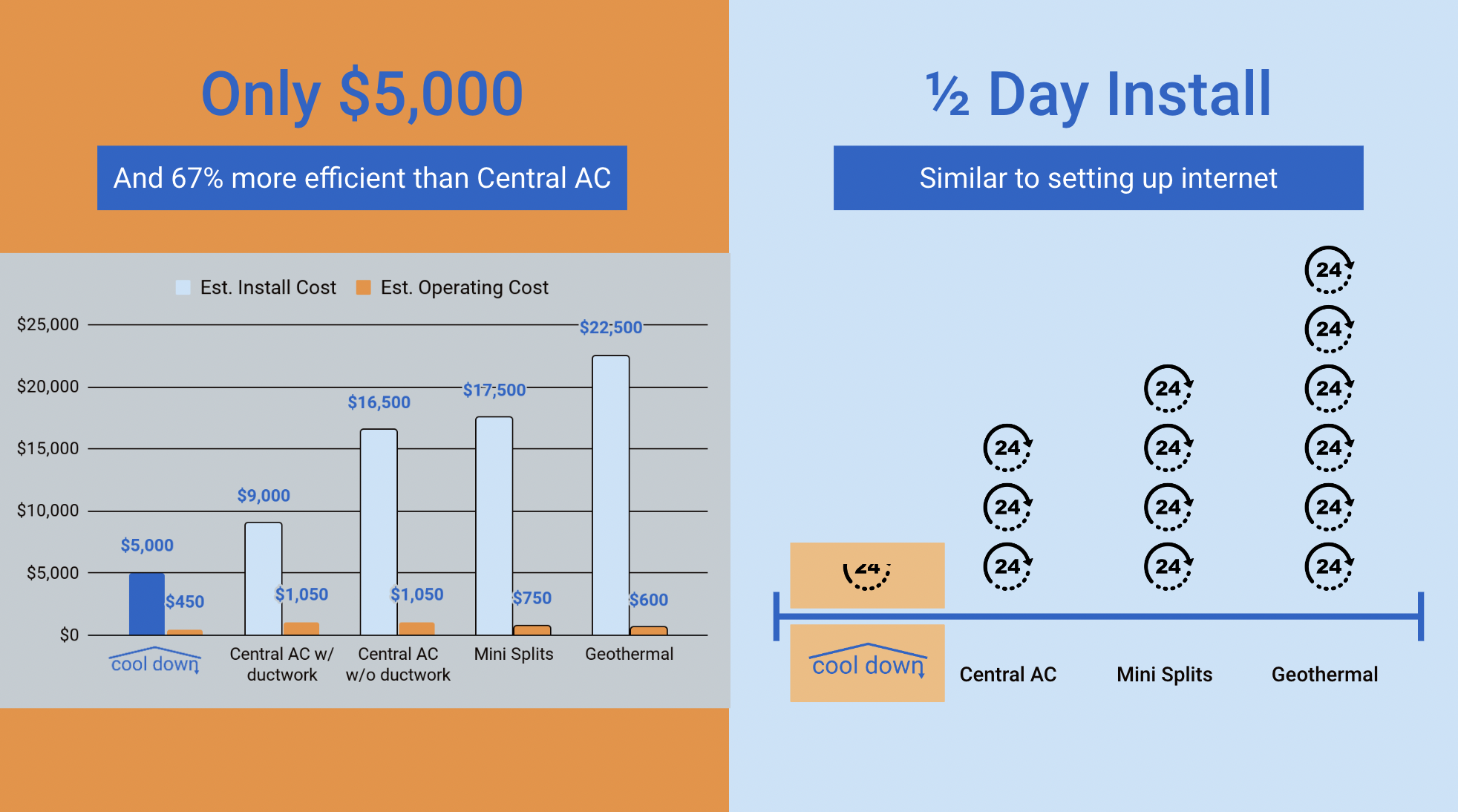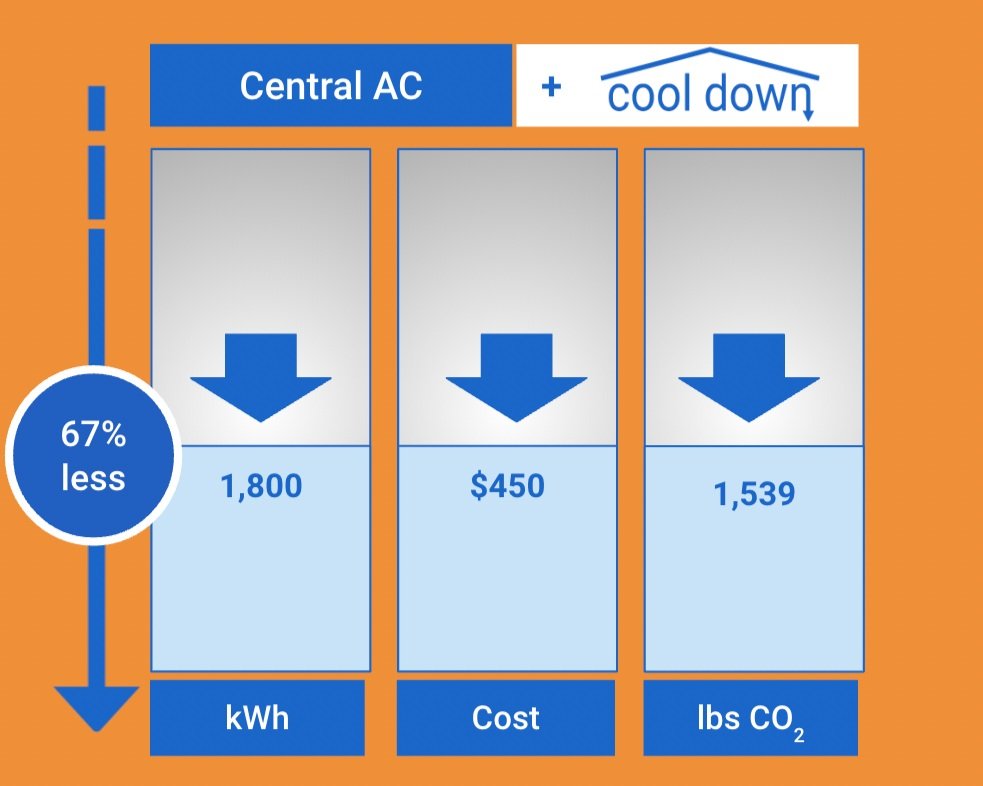The Advantages and Disadvantages of Different Cooling Solutions
Introduction
When it comes to cooling our homes, there are various options available to us. Each cooling system has its own set of advantages and disadvantages, making it essential to consider factors such as cost, efficiency, ease of installation, and visibility in and outside the home. In this post, we will explore and compare five popular cooling systems: central AC, mini-splits, geothermal heat pumps, window AC units, and Cool Down. By evaluating these systems against the specified criteria, we can better understand their strengths and weaknesses and make informed decisions about which solution suits our needs.
Central Air Conditioning
Central AC is a widely used cooling system that provides whole-house cooling
Cost: Central AC tends to have a higher upfront cost due to the installation of ductwork and the central unit. For Upstate New York, the cost of installing a central AC cooling system in an average sized home can range from $9,000 on the low end to $16,000 on the high-end.
Efficiency: The efficiency of a central AC system largely depends on the outside air temperature. The warmer the air temperature is outside, say 90 degrees fahrenheit, the harder the condenser has to work to cool your home, resulting in high energy bills in the summer.
Ease of Install: The installation process for central AC can be complex and time-consuming, especially if ductwork is not already in place. On average a central AC installation will probably take 3 or more days to complete.
Visibility: Central AC systems are not visible within the living spaces, as the components are installed in hidden areas such as the basement, attic, or mechanical room. However, every central AC system comes with a condenser unit which is typically placed on the side of the house. Apart from being an eyesore it is also loud when being operated.
Overall Score: 7/10
Note: If you already have Central AC you can still get Cool Down! Cool Down will reduce your central AC cooling costs by up to 67% a summer season.
Mini-Split / Heat Pump Systems
Mini-splits, or ductless systems, are gaining popularity due to their flexibility and efficiency
Cost: Mini-splits often have a higher upfront cost than window AC units, and central AC when getting quotes for a whole-home cooling system. However, the cost can vary based on the number of indoor units required. A homeowner in Upstate New York would expect to see quotes from $17,000 to $20,000 for a mini-split cooling system.
Efficiency: These systems offer excellent energy efficiency, allowing for zoned cooling and individual temperature control in different areas of the house. They can also provide heating during colder months. However, their efficiency, like that of a central AC cooling system, is tied to the outdoor air temperature. The hotter it is in the summer, the harder the mini-splits need to work to keep your home cool, which means higher energy bills.
Ease of Install: Mini-splits are relatively easy to install since they do not require ductwork. Installing them in finished space may require opening up your walls, or installing refrigerant lines on your walls.
Visibility: Indoor units of mini-splits are visible within the home, mounted on walls or ceilings. On the exterior of your home you’ll have to find space to install the condensing unit(s) and refrigerant lines.
Overall Score: 8/10
Geothermal Heat Pumps
Geothermal heat pumps utilize the earth's constant temperature to provide cooling and heating
Cost: Geothermal heat pumps have higher upfront costs due to the installation of underground loops. The cost for an average home in Upstate New York can range from $25,000 to $35,000 after incentives.
Efficiency: Geothermal systems are one of the most efficient because they utilize renewable constant temperature from the earth.
Ease of Install: Installing geothermal heat pumps can be complex and requires expertise. It involves digging trenches or drilling boreholes to lay the ground loop system. An average installation can take 6 full working days, over the course of several months.
Visibility: Geothermal systems are installed underground, eliminating any visible components within the living space. However, the installation process will leave your lawn / backyard in ‘rough grade’ form which will require landscaping to get back to what it was before installation.
Overall Score: 7/10
Window AC Units
Window AC units are a common and affordable cooling solution for individual rooms
Cost: Window AC units are typically the most cost-effective cooling option. They have lower upfront costs, making them a popular choice for renters or those on a tight budget.
Efficiency: While window AC units can effectively cool a single room, they are less efficient compared to central AC or mini-splits. They may consume more energy and produce more noise.
Ease of Install: These units are relatively easy to install, requiring minimal setup. They can be placed in most windows.
Visibility: Window AC units are visible within the home as they are installed in windows or through-the-wall openings. They can obstruct views and natural light in the area where they are Installed.
Overall Score: 6/10
Cool Down
Cool Down combines the efficiency of geothermal with the existing ductwork of a central cooling or heating system to bring you the most efficient and least expensive way to cool your home
Cost: A Cool Down system starts at just $5,000, which is a fraction of other whole-home cooling solutions. On top of that, the Cool Down system is significantly more efficient than central AC or mini-splits making it more affordable over the long-term as well.
Efficiency: A Cool Down system doesn’t need to rely on a condenser to cool a home, instead it uses the naturally cool temperatures in your basement as a heat sink for the high temperatures in your living space in the summer months.
Ease of Install: A Cool Down system can be installed in half a working day – about 4 hours.
Visibility: A Cool Down system is minimally visible in the home, just taking up a few cubic feet of space in your basement, with no outside equipment to maintain.
Overall Score: 9/10
Conclusion
Obviously, we’re a bit biased, but we believe a Cool Down system is a great fit for many homeowners. However, choosing the right cooling system for your home involves considering various factors such as cost, efficiency, ease of installation, and visibility in the home.
Ultimately, the choice of a cooling system will depend on your specific needs, budget, and preferences. It is advisable to consult with HVAC professionals to assess your home's requirements and determine the most suitable solution. By carefully considering the advantages.
Still interested in learning more about Cool Down? Click the button below to receive a quote.


